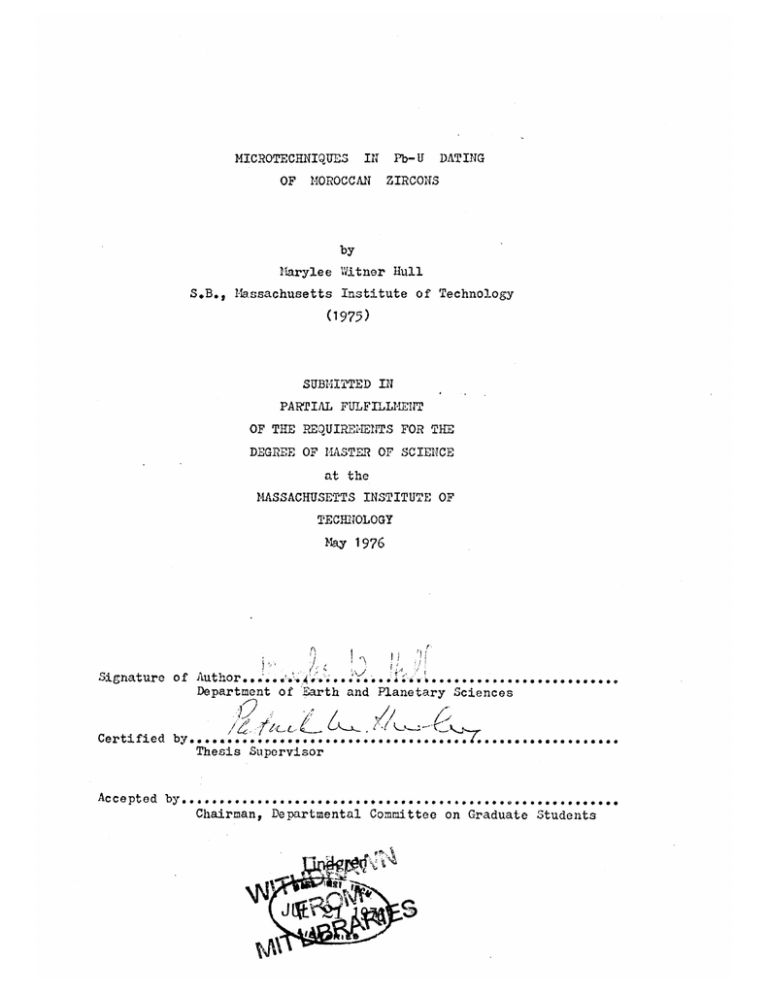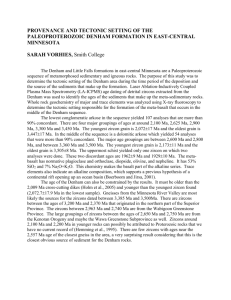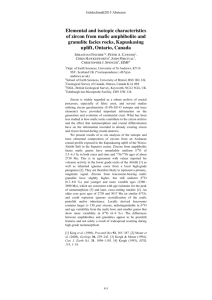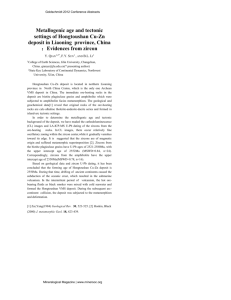(1975)
advertisement

OF Pb- U IN MICROTECHNIQUES MOROCCAN DATING ZIRCONS by Marylee Witner Hull S.B., Massachusetts Institute of Technology (1975) SUBMITTED IN PARTIAL FULFILLMENT OF THE REQUIREiMNTS FOR THE DEGREE OF MASTER OF SCIENCE at the MASSACHUSETTS INSTITUTE OF TECHNOLOGY May 1976 !PA Signature of Author... o.. .... .... . . ......... .. Department of Earth and -Planetary Sciences Certified byT . ..... , p..... s..--. Thesis Supervisor Accepted by............ ....... ....... ...... Chairman, Departmental Committee on Graduate Students 2 .; - NN Ns MICROTECHNIQUES OF IN MOROCCAN Pb-U DATING ZIRCONS by Marylee Vlitner Hull Submitted to the Department of Earth and Planetary Sciences on 'lay 11,1976 in partial fulfillment of the requirements for the degree of Master of Sc ience ABSTRACT Lead-uranium dating was performed on sedimentary zircons from Triassic and Paleozoic samples collected in the Moroccan Meseta. Three methods for the process of dissolution and loading were used. The standard bomb method, requiring the use of ion exchange columns yielded two valid data points, which, when plotted on a Pb-U concordia diagram, show an age of formation of approximately 1560 mya. Most of the samples processed by the standard boi:ib nethod, however, were contaminated by the ion exchange columns. Minibombs were constructed which which could dissolve small amounts of zircon and did not require the use of ion exchange columns. minibomb technique, small numbers of zircons were dissolved. In the first" The resulting solution was diluted vrith 3.1N. HC1 and. aliquoted into lead-spiked and leadunspiked portions. It was found that the dilution added too much contamination for the small amount of zircon used. In the second minibonb tecinique, a spiked sample and an unspiked cample, each containing one zircon, the need for dilution. were dissolved in separate bombs, thus elirminating Comparison of the lead ratios obtained by this method and those previously measured using the standard bomb procedure were similar. Therefore, Thesis Supervisor: title: the second minibob technique may be useful. Patrick 'I. Hurley Professor of Geology and Geocher-istry Table of Contents I,.Outline of the Geology of Morocco.,,.........................,,.1 II, Exlperimental Objectives,........,..................,,,..o. III, Standard Bomb Procedure,,.........,......o....,,e*.....*****C .8 Column Procedure.......,..............,,..............11 Siple Loading .... Contamination.. .. ..... ..... IV, The Minibomb.. First . ., ..... .,. Calculations.........,.., Results.,..,... ...... ... .,,..,,.... o ... ~,,~13 *. ......... 155.....,. ,,..........6 , ob ,,,........ ,,...............,,...b18 ,,.......b....... ........... bl...............19 .,............................20 dinibomb Technique,.. Second Minibomb Technique...*,............*....................22 ............. Bibliography........ Appendix.......... .. c.. , b# .b .............. ,.,.26 ,......,28 2.................... Figure I. 1ap of 1obrocco. (Outline from Th~ TIMeg Atlas Bartholomew, ed., 1956, plate 88. . the I ,orld J. RABAT C3 CASADLANCA 4v e' ~hES MARRAKECH Zenaga Plain SIDI Kerdous SCALE 1: 5,000,000 0 20 40 GO80 GoIO I - I I I II- II i30 (! I I. 'Outline of the Geology of Morocco Four separate regions in Morocco can be defined in terms of their different histories: the Anti Atlas, the Meseta, the Atlas Mountains, and the Rif. The Atlas Mountains provide the boundary between the Precambrian exposures of the Anti Atlas and the Paleozoic exposures of the Meseta. The Pif involves purely Tertiary activity. The Atlas Mountains did not begin to form until the middle of the Jurassic, at which time, there was only a modest amount of uplift. The sharp terrain of overturned anticlines and flysch did not begin to take shape until early CretaT'eous time. This activity continued through the Oligocene and Miocene when compressive forces folded the sediments and then overturned the folds. As a barrier between the Meseta and the Anti Atlas, the Atlas Mountains have really been effective only since the Cretaceous. The height of these mountains has made them the source for the younger sediments in the Moseta and those in the low areas of the Anti Atlas from Cretaceous or Tertiary times through the present. Thus, the effect of the Atlas Mountains on the adjacent Meseta has lasted only since the start of the Teriary. As the samples used in this study represent Paleozoic and Triassic sedimentary rocks from the Meseta, it is important to reconstruct the history of Morocco prior to the Jurassic period. The Anti Atlas block is an Eburnian(1800 my) igneous-metamorphic terrain, probably abutting the Reguibat nassif of northwest Africa until late in the Precambrian when a Pan-African event pulled it apart from the West African craton. event has been dated at between 650 my and 570 my. This The Pan-African orogeny involved massive rhyolitic and andesitic volcanism and granitic plutonism along the edge of the Anti Atlas. The effect of this event was to reset the ages in much of the bounding region. The Meseta, now separated from the Anti Atlas by the Atlas Mountains, is a very different landform. Mainly serving as a basin to receive sedi- ments from whatever sources existed on the continent, it has been measured to be 5 km. deep. sediments. This depthe was measured from the earliest known Paleozoic Geologists have had difficulty tracing the strata produced in the Meseta because of the persistent faulting that has taken place throughout its history. Outcrops of Paleozoic granites are evident throughout the Meseta. One such outcrop, the Tichka Massif, gives evidence of three separate igneous rocks emplaced at about the same time. diorite and mafic diorite. 2 The granite is surrounded by quartz Because of the pod-like shape of these outcrops, they are thought to be diapirs or large plutons. Indeed, gravity surveys have shown that the material extends underground far from the outcrops and is fairly shallow.3 Near the Atlantic coastline, the Paleozoic beds exhibit tight southeast-dipping fods. It is believed by some investigators4 that, during the early Paleozoic, the small Proto Atlantic Ocean began to close causing underthrusting of the Meseta. It was closed by mid to late Paleozoic time, but marine sedimentary rocks show that it was open again later in the Paleozoic at least on a small scale along parts of the African coast. The subduction of the Atlantic lithospheric plate underthrusting the Meseta may have caused many of the structural features visible today. The tight 1, P.M. Hurley, et al., "A Plate Tectonics Origin for Late PrecambrianPaleozoic Belt in Morocco," Geolcir(July 1974), 343. 2. l.A. Vogel and B.. Walker, "The Tichka 1assif, Morocco..," LIath; , 8 (1975), 31. 3. W.H. Kanes, et al., "Moroccan Crustal Response to Continental Drift," Science, 180(1973), 951. 4. P.E. Schenk, "Southeastern Canada, Northeastern Africa, and Continental Drift," CaL. j2iurai 21 LErth Science(1971), 5. L. de Loczy, "Synchronous Diastrophic Events...,," in Amer. Assoc. of Petroleum Geol. Memoir 23, C.F. Kahle, ed.,253. folds near the coast are thought to be a drag response to the subduction. Granite plutons of Paleozoic age dotting the Meseta are comparable to those in other subduction zones. Final collision probably occurred in the Hercynian. Toward the end of the Triassic, the current Atlantic Ocean began to open as North America and Africa pulled apart. The tension in the Moroccan crust is evidenced by the large horsts and grabens formed in the late Triassic and early Jurassic terrain. Daring the Jurassic, this faulting ceased as new crust was being added between the shores of North America and Morocco. The horsts and grabens formed are parallel to the Atlantic coast of Morocco indicating the basic direction in which the spreading took place. The spreading direction is approximately parallel to the direction of underthrusting during the Paleozoic. However, it is not certain that the location of the separation line between North America and Morocco corresponds with the suture that resulted from the closing of the Proto Atlantic. Subsequent uplift of these filled Jurassic basins occurred in Alpine times so that they now constitute part of the structure and stratigraphy of the High Atlas Mountains. 6. W.H. Kanes, et al., 9a,git., p. 952. II. Experimental Objectives Six sand and sandstone samples collected from the leseta were processed in order to provide geologically interesting material for the microchemical techniques to be examined in'this thesis. The objective was to carry out lead-uranium dating on the zircons they contained. These samples came from late Paleozoic and early Triaeoic formations. Firstly, it was important to determine the source of the sedimente filling the Meseta basin, ^z...reo Several possible sources of boundaries of Erocco. est Cne likely candidate is the Pan-Afrtcan volcanic aenarateing the Anti Atlas stable block from the ~eseta. ,aterial the "tithin Another source might be the ]aleozoic plutonic exposures wid~ly visible on the Lastlyin Morocco are the Anti Atlas chains. 4eseta. The Atlas .Muntains and the orogeny associated with the Rif came later and would not have influenced these setdiments. One thecry, though, is that the Meseta was not originally part of Morocco. As the nature of the South Atlas Fault is in Question, it has been suggested that the Meseta was transported along this strike-slip fault to its present There exists the possibility, then, that many of the Paleozoic location. sediments of the Meseta have their source on the other side of the Atlantic. Dting the Moroccan zircons can give two important pieces of information. Of basic importance is the question of the historical position of the Meseta. The ages of the zircons will show whether their-sources can be explained to be in Morocco or whether they must be somewhere else. If the age of the sedincntary zircons does does correspond with that of one of the igneous formations or if it of the igneous formations of Morocco, falls somewhere in between the ages we can deduce which landforms had positive expression through the early Triassic. 5 Another purpose of this work is to initiate a series of experiments to determine the boundaries of the various tectonic activities that have affected 1orocco. The Proto Atlantic closed forming a suture line at the edge of the Meseta. In the 1esozoic, The Atlantic opened along a line somewhat parallel to the suture but possibly not exactly the same line. The possibility exists that either part of the North American continent is now attached to Morocco or that part of Morocco is attached to North America. Meseta. There is very little evidence of a suture in the present-day It is therefore possible that the suture exists somewhere on the North American continent. Collecting samples from the Paleozoic formations along the east coast of INorth America would allow a study of the zircons found in them, A zircon age similar to that Of the Meseta zircon age would be convincing evidence that part of the Pre-Atlantic Meseta is now part of North America. Rubidm-strontium age studies of the igneous rocks of the eastern United States seaboard yield ages of 600- my to 250 my. The only areas in North America which have ages comparable to that of the Eburnian orogeny as in the Anti Atlas are found along the Grenville front and in the Churchill province of Canada. derived from the typical Thus, if the Meseta zircons are West African craton, they should be very distinctive in North America. The Moroccan Meseta is quite small relative to North America, however. It is important to know where to look for Moroccan zircons. It has been proposed that the South Atlas Fault system is the eastern end of a transform fault that cuts across the tMd-Atlantic Ridge. 8 Below the latitude of the South Atlas Fault, the ridge is shifted slightly to the east. It has been noted that the Canary Islands, just off the coast of Morocco, may have some 7. 8. eol. material on the easternmost island which resembles Moroccan Jurassic P.M. Hurley, personal communication. W.C. Pitman and M. Talwani, "Sea-Floor Spreading in the North Atlantic" Sgec. America lulL, 83(1972), 635. sediment.9 There is also evidence of folding and volcanism on the Canaries that resemble the tocene activity of the South Atlas Fault. Therefore, it seems likely that the Canary Islands fall along the South Atlas Fault line and are part of the Moroccan Meseta. The line that connects the South Atlas Fault with the Canary Islands and the offset in the MtLd-Atlantic Ridge should intersect the rNcrth American continent in an area most likely to have Moroccan sediments. section is, There is some question as to where the inter- Some have proposed that the New England seamounts are the westernmost expression of of this fault. the fault extends farther south. 0 It is possible, though, that In either case, it would be most likely to find Moroccan sedimentary rocks in the New England area. Therefore, the two geologic purposes of this work are to find the source of the Meseta sediments and to lay the groundwork for further tectonic reconstruction through the age-dating of detrital zircons. In dating the Moroccan zircons, several techniques were used. The experimental objective of this work was to develop the microtechnique of age-dating after first using the standard procedure and equipment. Development of the micro- technique first involved reproducing data already obtained using the standard method. After the initial testing of the microtechnique using minibombs constructed by the MIT gcology rachine shop, the plan was to use these minibombs to find the ages of single zircon grains found in the larger mixed suites. In this way, it would be possible to more accurately determine the sources which contributed to the Paleozoic and Triassic zircons. 10. Ibid., p. 634. Sample Descriptions The samples used in this study were collected in the northern part of the M~roccan Meseta and in the Casablanca area by John Lorenz and Guy Padgett of the University of South Carolina. The sample descriptions are as follows: 8530- Lower Carboniferous graded fluxoturbidite 8532- Basal'Triassic red sandstone 8533- Tr'iassic red sandstone 8534- lBasal Triassic red sandstone and shale 8535- Triassic red sandstone and shale 8536- Dark heavy beach cand from Cmcr Rbia, 60 km. south of Casablanca _ ~ Figure 2. I_ -- - Map of the northwestern Meseta including the sample locations of numbers 8530, 8532, 4' 8533, 8534, and 8535, SALE Si Allai el Bahraoui RABDAT/ a 0 X'V 0I 1 NE EN 8530 Si Bettache III. Standard Bomb Procedure • Preparation of the samples for mass spectrometry involved two processes: the physical separation and cleaning of the zircons and the chemical separation of the various components of the zircons. For the first process, no concern was taken for the introduction of chemical impurities from the air or the equipment used. It was assumed that the later cleaning would remove any recently added lead or uranium, In the second process, however, great care was taken to avoid lead contamination. As five of the six samples used were sandstones, they had to be disaggregated first. form. The other sample was a beach sand and could be used in original The disaggregated material was then put through a stack of sieves of the following mesh sizes: 50, 270, and 325. The material larger than 50 mesh was set aside to be reground if needed. have been much smaller than this material. was also set aside. A:ll of the zircons found The powder less than 325 mesh Although this material was often found to contain a high proportion of zircons, it was difficult to work rith and was used only as a last resort. The grains between 50 and 325 mesh continued through the process. In order to separate the zircons of specific gravity 4.68 from the other minerals of specific gravity 2 to 3 in the sample, a heavy liquid separation using acetylene tetrabromide of specific gravity 2.955 was performed. The light fraction, mostly quartz and feldspar, was discarded, and the heavy fraction cleaned several times in acetone. Those samples which had ccrm oxidized iron. rom sandstones were heavily coated with They were cleaned by being heated in 6N HC1 under a heat lamp until all the iron was dissloved. Water and acetone were used to clean out the HC1. At this point, the remaining grains were put through a second heavy liquid ___ _ _I _ separation of methylene iodide, whose specific gravity is 3.3. This liquid floated some of the minerals that remained from the previous separation but sank the zircons and a few other minerals. sank along with the zircons was nagnetite. One of the minerals that After the heavy separate was removed and cleaned with acetone, the magnetite was removed with a hand magnet. The next separation was performed with a Franz magnetic separater. is one of the least magnetic minerals in the sample. were made with the magnet current set at 1.5Amps, the yaw- set at 15 0, 5 10, 20, Magnetic separations the pitch at 100, and and finally at 1 . were nonmagnetic at the 2 setting, Zircon of the trains that usually at least 30% were zircons and The further division at a 10 setting was made often as many as 90% were. to obtain two usable fractions of zircons. These two fractions were then washed in warm, high-purity 7N HIO3 for two 15-minute periods. 15-minute periods. They were then washed in 4* water for two more This cleaning was supposed to remove any lead or uranium that had become attached to the surfaces of the grains through exposure to impure air or metal. Immediately after cleaning, the grains were dried under a heat lamp and put through another stack of very clean sieves. 150, 250, and 325. The mesh sizes used were This way, both the magnetic fraction and the nonmagnetic fractions could be further subdivided into three size fractions apiece. It was hoped that the results of several size fractions could be plotted on a lead-uranium concordia graph to form a well-substantiated line. The chemical process of dissolution followed. basically those of Krogh. 11 The procedures used were A small amount of pure zircon, usually weighing 11. T.E. Krogh, "A Low-contamination Method for Hydrothermal Decomposition of Zircon and Extraction of U and Pb for Isotopic Age Determination," Cosochimica A a, 37(1973). ica Geohi _ _ _ between 1 and 10 mg., was selected by hand picking with a paintbrush and discarding the nonzircon grains from the cample. in the teflon capsule of the bomb used. ultrapure HF and a few drops of ITNO The zircons were placed Approximately 2 ml. of concentrated were added to the zircons. The assembled bomb was heated in a 205 C oven for a week.. After the bomb had cooled, the liquid in the capsule was evaporated, and a large drop of L7 spike was placed in the capsule and weighed. Approximately 2 ml. of 3.1N H01 were added to the capsule, and the bomb was placed in the oven overnight. When the bomb had cooled again, the liquid was aliquoted into two small beakers, and a weight of Pb2 0 8 spike was added to one aliquot. The two portions were then put through ion exchange columns whose purpose was to separate the lead and uranium ions from each other and from all the other ions present. Pure samples of lead and uranium were obtained, and the recovery rate for these two elements was estimated to be 98%. Column Procedure The column apparatus was partially enclosed by plastic shields, and a steady flow of filtered air was pumped into the enclosure and allowed to escape through an opening in the front. This process created a clean, dust-free environment for the columns. In the use of the ion exchange colUtans;'t was first necessary to remove any used resin from the columns. Approximately one column length of 6.2N HI1 was poured into the empty columnl and allowed to drip through the frit in order to remove any lead that remained in the column. When that had dripped through into the plastic container beneath, a column length of 4 water was was poured in and allowed to drip through to remove the uranium. Next, the resin, Dowex 1x8 200-400 mesh, was added. The resin was kept in a slurry in 4* water, and enough of this slurry was added to provide a 3/4" column of resin when the excess water had dripped out. In order to clean the resin, one column length of 6.2N HCI was added and allowed to drip through. An equal amount of 4* water was then added. was performed at this point. A conditioning step The One column length of 3.1N HC1 was added. columns were then ready for the sample. The spiked and unspiked aliquots were added to separate columns. After the acid had dripped through, the zirconium was eluted with one column length of 3.1N HC1. All the liquid that had.been collected from the columns up to that point was discarded, and the teflon beakers used in the aliquoting process were placed under the columns in order to collect the lead fractions. The lead was eluted with a column length of 6.2N hiZ1. It :.as then allowed to evaporate under a heat lanp in a laninar flow of air. Daring the evapor- ation, the beakers were placed on a sloping surface with their spout sides low. This way, the final deposit of lead can be located. As the uranium spike had been added before the aliquots were made, the uranium solution was eluted from both the lead spiked and the lead unspiked columns. This was accomplished by pouring a column lengthof 4L w-ater through each column. The uranium was collected in a small teflon beaker and evapor- ated in the manner described above. Sample Loading -;Toprepare the sample for mass spectrometry, two or three drops of 0.75N H P04 were pipetted into the beakers of the evaporated lead and uranium. The beakers were heated under a heat lamp to equilibrate the solution. The spiked and unspiked portions of lead were loaded onto separate Re -filaments which had prviously been cleaned by being heated with an electric current of 4Ampsin a vacuum chamber. This process of heating was a pre- cautionary measure to prevent material of any sort that night stick to the filament from contaminating the load. A large drop of silica gel solution was pipetted onto the filament and allowed to dry under the heat lamp. Generally, a second drop was then pipetted onto the filament and allowed to dry. or three drops of the lead-iiPO gel and allowed to dry. glass. In a similar manner, two solution were pipetted onto the silica The final product looked like a lumpy, transparent The filament was then subjected to a slowly increasing current of between 0 and 2.5 Amps. off as a gas. The lead oxtdized, and the excess H PO was driven When the flow of gas diminished, the filament was ready to be loaded into the mass spectrometer. The appearance of the load was usually a&hy black. The uranium loading process tfas slightly different. The filament used did not need to go through the process of heating and evacuation because there was virtually no urarnium contamination in the air. One drop of Ta205 solution was pipetted onto the filament ard allowed to dry under the heat lamp. Then, two drops of the uranium-11 PO the filament and allowed to dry. :solution were pipetted onto Tho filament was then subjected to a 2.5 Amp current, and the substance on the filament turned from a thin, beige coating to a shiny black one. One pipette was The pipettes used during this procedure were glass. designated for each separate process, and the pipettes were rinsed thoroughly with 4* water before and after each use. were kept well wrapped in plastic. 'Whennot in use, the pipettes The beakers used to collect the samples had been rinsed in 1:1 HC!l and water, soaked in a detergent bath for several days, rinsed in 2* water, and then soaked in hot 1:1 HN0O for 30 minutes. After being rinsed in 1* water, they were left to drip dry between two Clean beakers were kept in a sealed plastic box,. layers of tissue, Equipment Needed for Column Procedure and Loading 5" long sections of Teflon MEP tutbing with the lower 1i" porous polyethylene disc Dowex Ix8 200-400 mesh, chloride form in slurry with 4* water Ultrapure 6.2N HC1 Ultrapure 3.1N HCI 5 ml. teflon beakers(for uranium) 3 mi. teflon beakers(for lead) 30 ml. plastic beakers(waste liquid from columns) Ultrapure 0.75N HR 3 P4 Ultrapure silica gel 3 glass pipettes Syringe Heat lamp in laminar flow of air shrunk to hold a Contamination It was found from mass spectrometry that a large amount of lead contamination had entered most of the samples. The contamination level varied from sample to sample to sample and sometimes between the two aliquots of the same sample. This variation in contamination eliminated the possibility that the problem was in the laboratory air, incomplete cleaning of the bombs, or bad loading procedure. The most likely source of the contatmination was in the ion exchange columns. Although the prescribed cleaning procedures were used, the columns dripped more and more slowly with time, indicating that the frit was being gradually clogged. The columns were being used by several people and were used for separating lead and uranium from whole rock samples as well as zircon samples. It was likely that the lead contamination was caused by whole rock compounds that did not respond to the cleaning procedure. In the future, separate sets of columns should be used for whole rock lead work and zircon work. Also, the columns should be cleaned regularly with HF to insure that all the lead is cleaned out and one set of results does not psrpetuate itself with each use of the columns. while a strong measure, the colmzns, The H; cleaning, should be carried out after four or five uses of Calculations In order to use results from runs in which the two aliquots had been contaminated by different amounts, a set of calculations was developed to reduce the lead isotope ratios of the more contaminated aliquot to those of the less contaminated aliquot. Subscripts used: A- unspiked aliquot B= spiked aliquct C- co:tainated L= less contavinated (h 20/Pb206 208 2006 ) (Pb /(b/) = (Pb207/P 20 6 ) ,kL Hypothetical set of measurements obtained from mass spectrometry( equaticrns ay be s d for reversed i 1tuation): (8/6) = (/6 (7/G)AC L (6/4)AC Need to solve for: (6/4) (8 /6)( M o 20 o6207 608 7i :Pb 2 :Pb :Pb found in ethod: Using known ratio. of Pb Atlantic contamination, northwest find the number of moles of contaminant subtracted from the contaminated aliquot to yield the ratios the uncontaminated aliquot. iBecause Pbn2?/072b0 6 and PbL~ 0 6 /Pb of 20 4 should be virtually Uhchanged-inthe two aliquots(Pb207+PO 2 06+Po 2 0 4 make up less than 2% of the lead in ratios may be used in 1. (8/) either or both the following procedure. .in the a~ r t of each isotope of Pb in one mole of total Pb present. mole the spike), 6)AC Aliquot A acu.uming for si:plicity )A (66)AC I .p206r,2O -)-20 (Pb 2 0 ) a(pb27C (Pb 206 (7/6)A,.cC ) (S! mole 2. ___ " C +". , ,, Find the amount of each isotoe -on,.1e o total contaminant ~ame - ,"f c otaxi:,nt C load by 1ros "' ' the s "i, d Pb , prent "in (7/'), ' 1 2~ .rle of2Ialiquot A's lead in c ~oir to change the A ratios to ta.n~ated B ratis, Using the 7/C ratios: (Pb ) (Pb- ).- - N(b-0 7 ) ,h 4. ) be checked by folloing Using the kno-rn value for N, (Pb 206 ) AC - the uncon- = (7/6) "ihe value obtaind3 -ay for N ',ith the 6/4 ratios. TN( 36 ' ) A solve for (8/6A 'AL i " " the same rocure STwo valid data points were obtained from the procedure described above. The numerical values given by the two samples are summarizod in the fo-llowing table. Sample Pbb20P8 ~/gm b207,m Pb C..) Pb 206 206 /gm 207 ,Pr_ 3"7 r);Lr r '?~/ ,.~ ,_L 3 C*;LC~ 8534M 17.35 11 9 128.18 .15% 2.0I 1'Vr~y 853,6 16.00 13.27 14,4 .12550 1.5443 1410ho y -250 The plot of these points on the lead-uranium concordia diagran allows a cord to be drawn. This cord intersects the curve at an age of 1560 my. This intercept aqe an d the P'n / 0 ages for th two amples are all yoinger than the corresponding ages obtained from beach sands in the North African countries east of Morocco. The Pb207/Pb2 0 6 ages of these sands fall between 1635 my and 1967 my, and their upper intercept is at 1735 my. 12 12. H. Gaudette, personal communication. Figure 3. Uranium-lead concordia diagran, showing the positions of the Pb206/ b207values for samples 8334 and 86. the curve at arproximately 1560 my. this is The cord intersects It is, therefore, the age of formation of the zirc C . assumed that 38 Pb 2 2 38 U .35 .253 I600 .2 5 .2 1000 34 .15 8536 .05 .05S .5 15 2 Pb 207 2.5 25 3 35 IV. The 1Initomb Because of the pontamination problem encountered using the standard bomb procedure, a new method was needed in which the ion exchange columns were not used. As success had been achieved at the Institut du Physique du Globe using minibombs for the dissolution of single zircons without using any column work, we decided to try this method in the dating of the Moroccan zircons. The minibomb is made up of several parts. A teflon capsule held by a thin teflon sleeve holds the zircon grain and dissolving acid. Lateral pressure on the capsule is exerted by a monel cylinder slightly taller than the capsule. Pressure is exerted on the top of the capsule by a monel disc which has the same diameter as the capsule and fits inside the cylinder on top of the capsule. top of the cylinder, a spring on it. The top of the disc is raised above the On top of this disc is placed a larger disc with This larger disc exerts pressure directly on the smaller disc in order to keep the capsule shut. in a monel casing with-a screw-on lid. The whole assemblage is enclosed This lid must be screwed very tightly to put pressure on the spring, which in turn puts pressure on the larger disc. 13. J. Lancelot, A. Vitrac, and C.J. Allegre, "Uraniom and Lead Isotopic Dating with Grain by Grain Analysis: A Study of Gomplex Geological History with a Single Rock," 9=th Aid P -lanetary Spin Letters, 29(1975), Figure 4I. The top(above) and bottom(below) of the outer casing of the minibomb. The dravrings are in cross-section, and the thread pattern is printed on the bottom piece. in inches. All dimensions are 1.96 .89 1.01 1688 .26 L8----------- . L8 1.926 1. 0 15 1.168 1.~ 88 Figure 5. Cross-sections-of minibomb parts, from upper to lower: 1. The large pressure disc containing the well which houses the spring. 2. The small pressure disc, which fits inside the inner cylinder. 3. The inner cylinder. 4. The bottom piece made of two concentric discs. This piece fits into the bottom of the outer casing and supports the inner cylinder and the capsule. Dimensions in inches. J715 1.168 .34 LZZZ .85 Figure 6. Cross-sections of the:.partsof the teflon capsule, from upper to lower: 1. Lid of the capsule. 2. Base of the capsule. 3. Sleeve which fits over the assembled capsule. .9 84 .6 69 I. 15 .723 I L' C'-- ; - 1.4 .. 1 ,J 20 First tMnibomb Technique The new teflon capsules and sleeves were cleaned in the same way that all the other teflon and glassware were. of reagent grade HC1 and tap water. solution for 3 days. They were rinsed in a 1:1 mixture Next, they were soaked in a detergent After being rinsed with 2* water, they were soaked in a near boiling 1:1 solution of reagent grade HNO and tap water. Pieces were left to dry between 2 layers of tissue. The bombs were then The cleaned by loading the capsule with 2 drops of ultrapure HF and leaving the assembled bombs in a 2050C oven overnight. The procedure was repeated with fresh acid for a second night. Between uses, the bombs were cleaned by soaking all the parts except for the spring in a weak solution of N3 and tap water.for 2 hours. were then rinsed and left to dry in the open air. They The spring was quickly corroded if put in the acid solution, so it was claned by rinsing with tap water. The bomb was then assembled and given the same double overnight cleaninE.described above. In loading the bomb, a plasticpipette was used for the HF. was used only once and then discarded. Every pipette Two drops of HF were added..to the 2 or 3 zircons in the capsule, and the bomb was placed in the oven for a period of between 16 and 24 hours. A teflon beaker was labeled and weighed, and the contents of the capsule were placed in the beaker. After covering the beaker and placing it in a well-wrapped box, we put 2 drops of ultrapure 11.2N HCI.ito the capsule and put the bomb back in the oven for a period of from 8 to 16 hours. In this way, most of the lead from the zircons could be extracted from the dissolution capsule., The HC1 was deposited in the same beaker,after the bomb had cooled. The contents of the beaker were evaporated to dryness during the first trials according to the procedure __ _____ __~ ___ _____ of Lancelot et al. 14 For the purpose of spiing such small amounts of solution, both the lead and uranium spikes were diluted in 3.1N HC1. b38/U23 5 ratio were obtained using a b moles 235 /ml. 35 Good values for the spike concentration of 7x10 The concentration of the Pb201spike used was 1.6x10 9 moles Pb208/ml After the sample had evaporated, one drop of the dilute U235 spike was weighed into the beaker. At this point, more 3. 1 HCl was added to increase the volume of liquid In the beaker to approximately i ml. After being allowed to equilibrate for a few minutes, the loution was aliquoted, and one drop of the dilute Ph08 spike wae r*-h'd into the beaker. The t0o aliquots were then evaporated to dryness and loaded onto filaments for mass spectronetry. The loading procedure used was the same as that used for loading the lead solutions onto filaments in the standard bomb procedure. The following table of results shows that there was a large amount of contamination introduced during this procedure. For comparison, I have placed one of the successful results from the standard bomb method at the top. Sample It is weight of zircon (grams) weight of acid added (G'ranz.) evident that the ratio of 3.1 0 207 26 aC1l added and the weight of the zircons used is somewhat proportional to the quality of the results. Using such small amounts of zircon made the lead content of the reagent critical, and our HCL was not pure enough to be used in such large quantities. 14. Ibid, 20 ~ Second Minibomb __ Technique A second technique was used to reduce the need for reagents and to intensify the efforts to keep the sample clean. For this method only one zircon was A zircon was dissolved in each bomb to reduce the error of selecting grains. picked with a paintbrush and deposited in the teflon capsule. of similar size and shape was placed in another capsule. A second zircon Two drops of HF were pipetted into each capsule using the plastic disposable pipettee. Into one of the capsules were weighed one pipette drop each of the dilute V35 spike and the dilute P208 spike. Both capsules were placed inside their metal casings and left in the oven overnight. After the bombs had cooledi the capsules were removed and the contents evaporated by placing the contents in separate-covered teflon vessels under a heat lamp. Two drops of 0.75N H PO were pipetted into each capsule. The capsules were then placed in their respective teflon evaprating vessels and allowed to heat for a few minutes to equilibrate.the acid and powdered zircon. The pipette used to take up this solution and load it onto the filament was washed in 6.2N HC1 and 4* water before and after loading. As much of the sample as possible was loaded onto the filament as the original sample had been so small. Otherwise, the loading procedure was the same as the lead loading procedure discussed before. The cleaning procedure between uses of the bomb was changed. Each time the bomb was used, the capsule and the sleeve took on a residue from the metal parts of the bomb.. This residue did not come off during the normal cleaning procedure. HC1 Therefore, and water. the teflon pieces were washed well in 1:1 reagent grade After being rinsed in 2* water, they.:.soaked in a near boiling solution of 1:1 reagent grade HN 3 and water for 30 minutes to an hour. This process was very effective in removing the residue and was used after each use of the bomb. The metal parts of the bomb except for the spring were soaked in a dilute solution of HiO for two hours, rinsed, then allowed to dry. The bomb was then loaded with two drops of RF and left in the oven overnight. This procedure was repeated a second night. To test these new cleaning and loading procedures, several measurements of lead isotope ratios were made on a zircon sample from Tunisia. The ratios from this sample had previously been measured by Professor Henri Gaudette of the University of New iHampshire. The following table shows the comparison of his results using the standard bombs under ideal conditions and my results using the small bombs. Sample 8180' 208 20 Pb stan~dar bob i nibomb 207 6 206 .1557 ,10055 .46157 .20332 .31483 .16490 206 Pb20 ros 146.006 180.101 It is apparent that the standard bomb contamination level was lower than the minibomb level. The amount of contaminant lead in each minibomb load was calculated to be 1.3 ng. However, these measurements show a great improve- ment over the measurements made with the first minibomb technique. It is possible to correct for the lead contamination in these measurements with a fair degree of confidence. The ratio of the contaminating lead in this technique was calculated-to be approximately 1:36:17:41 for Pb2 0 4 :Pb2 0 6 :Pb207:pb20 8 The weight of the zircon grain used had to be estimated. The error in such an estimation does not affect the corrected values of the lead isotope ratios much. It does cast doubt, however, on the value of the uranium-lead ratios obtained by this method. More precise measurement of single grain weights is needed before these values can be used on a uranium-lead concordia plot. " _ __ _ __ __ Assets and Problems of __ _ the _ _ _ Minibomb Usage of two minibombs, one containing a spiked sample and the other, an unspiked sample, cimulates" the situation in which one larger sample is split into smaller aliquots. The ratios of Pbo8/b 206 , Pb 207/Pb 206 , and Pb206/Pb204 were measured on the spiked sample. The ratios Pb 'nd8 35 206 208 were measured on the unspiked sample. and /Pb 38/35 WVhereas, in the standard bomb procedure, three filaments had to be loaded to make all the necessary measurements, this method requires only two filaments. This amounts to a sairing in filaments and ini loading tim . It was found that a single zircon groin larger than 150 n-esh created a strong enough signal on the mass spectrometer to measure even the very high 206 ratios of P2 0/1b the signa is is 004 T.:ro difficulties were encountered, though. slightly less stable using the minibomb technique. -_rst, This problem at least partly caused by the presence of many other elements like zirconi.um, which are removed by the resin in the ion exchange columns. These elements cause the load to be less well-ordered and, therefore, less stable. The second problem is the large number of peaks indicating the various elements present. The uranium peaks, though strong enough to be measured, are often hard to distinguish from the surrounding peaks. Aside from the results obtained using the mir-ibombs, their design has important effects on the ease with which they can be used. The design is especially good for removing the teflon capsule after the assemblage has been in the oven. It is easy to get the inner monel cylinder out of the outer casing and force the teflon capsule out. .This is important because the teflon capsule and sleeve flow during their time in the oven and can stick to the sides of the cylinder. Their small size would make them difficult to remove if both ends of the inner cylinder were not open. Evaporation of the liquid from the capsule is one of the hazards of the minibomb because there is so little acid placed in the capsule to begin with. Any loss of acid and dissolved zircon would lessen the possibility of getting strong enough signals during the mass specrtoscopy. a solution to this problem. Again, the design provides The small pressure disc that fits on top of the capsule is in contact with the larger pressure disc that fits inside the top of the caseing. it tightly sealed. Thus.there is direct pressure on the capsule to keep The spring seated in the upper pressure disc moderates the pressure created by screwing the top on. However, it also provides a continuous force on the small pressure disc while the capsule is undergoing flowage during heating. A slight shortening of the capsule does not drastically reduce the pressure on it. The top must, therefore, be screwed on tightly. Several of the capsules used experienced shortening during the course of several uses. the capsule. The teflon capsule and sleeve flarsd out at the bottom of As there was no direct pressure on the inner cylinder, it was not prevented from moving slightly and allowing the teflon to flow under it. The shortening of the capsules caused the small pressure disc to seat lower in the inner cylinder. At the point at which the pressure disc's top was nearly leve with the top of the inner cylinder, a steady state was reached. The capsule remained the same length and did not expand at the bottom any more. This result suggests that, in the future, the design of these minibombs should be modified to allow for a shorter capsule and a small pressure disc more nearly level with the inner cylinder. One other problem experienced with the bombs was that the heavy tightening needed to create sufficient pressure tended to chip and deform the threads on the outer casing. It was apparent that the extreme tightening might shorten the life of the bomb. Bibliography W22 r2d, mid century edition, A'i -At T21Se Tt Bartholomew, John, ed., 1956. Press, Vol IV, C&mbridge, Riverside Bullard, .Sir Edward, Everett, J.E., and Smith, A.G., "The Fit of the 2g. London Phios Trane, Continents Around the Atlantic," o.al 41-51. No. 4-258(1965), Charlot, R., "Geochronological Studies in the Moroccan Precambrian," lr a Fortschritt!e gA ineraoie, L, no. 3.(1973), 57-59. , "Etude Geochronologique des Granites du Massif de Tafraoute. arthF th Science, XII, no.1, (Anti Atlas Marocain)," Can. Jounal (1974), 19-23. , "The Precambrian of the Anti Atlas(Morocco): A Geochronological Synthesis," Prc mbrlan Regearch, III, no. 3(1lay 1976), 273. Charlot, Ren4, Choubert, Georges, Faure-Muret, Anne, and Tisserant, Daniel, "Etude Geolchronologique du Precambrien de L'Anti Atlas(laroc)," Ntes eric GeoloZi-ue ar cQ, XXX, no. 225(1970), 99-134. Clifford, T.N., "The Structural Framework of Africa," in Clifford, T.N., Darien, Ct., and Gass, I.G., eds., African 1Matism nnd Te-onic.s, Hafner Publishing Co., 1970. Hurley, P.M., Boudda, A,, Kanes, W.H., and Nairn, A.E.M., "A Plate Tectonics Origin for Late Precambrian-Paleozoic Orogenic Belt in Morocco," Geology, V(1974), 343,344. Kanes, W.H., Saadi, M. Ehrlich, E., and Alem, A., "Moroccan Crustal Response to Continental Drift," 9ciene, CLXXX(1973), 950-952. Krogh, T.E., "A Low-contamination LMethod for Hydrothermal Decomposition of Zircon and Extraction of U and Pb for Isotopic Age Determinations," _hi Comochim. Ata, XxVII, no. 301973), 485-494. Kruger, Harold W., "K-Ar Dating of Moroccan Dolerites," V, no. 7(1973), 700. ol- SQ J& A.ctr , Lancelot, Joel, Vitrac, Annie, and Allegre, Claude J., "Uranium and Lead Isotopic Dating with Grain by Grain Analysis: A Study of Complex = a~netar-y Scince Letters, Geological History with a Single Rock," 1IDdj XXIX1975), 357-366. Loczy, Louis de, "Synchronous Diastrophic Events in South America and Africa and Their Relation to Phases of Seafloor Spreading," in Kahle, C.F., ed., Rassessments: Amer. Assoc. of Petrol. ic- Assessments a a_ Tec Geol. Memoir 231974), 246-254. 27 Loomis, T.P., "Tertiary Mantle Diapirism, Orogeny, and Plate Tectonics East of the Strait of Gibraltar," -merican J urnal 1 Scince, CCLXXV(1975), 1-30. Mattauer, M., Proust, F., and Tapponier, P., "Major Strike-slip Fault of Late Hercynian Age in Morocco," Nature, CCXXXVII1972), 160-162. Michard, A., Westphal, M., Bossert, A., and Hamzeh, R., "Tectonique de Blocs dans le Socle Atlaso-Mesetien du Maroc; Une Nouvelle Interpretation des Donnees Geologiques et Paleomagnetiques," Eath a PRate y science Letr-, XXIV, no. 3(1974), 363-368. Padgett, G.V., and Ehrlich, Robert, "Late Paleozoic Source Terrains in Western Morocco," aarans.s Gehyvs Unios LV, no. 4(1974), 445. Pitman, W.C.,III, and Talwani, Manik, "Sea-Floor Spreading in the North Atlantic," Geog _, 3 ., .L 11, LXXXIII(1972), 619-646. Schenk, P.E., "Southeastern Atlantic Canada, Northeastern Africa, and Continental Drift," Canadian £_ U jrthc a ~eartce , VIII(1971) 1218-1251. Termier, Henri, Termier, Genevieve, Leutweein, Friedrich, and Sonet, J., "Sur L'Age Varisque des Plutonites du Misif du Tichka(4Maroc)," Bl._ I iUnel. Cristallorr., XCV(1972), 124-127. Vogel, T.A., and Walker, B.M., "The Tichka Massif, Morocco-An Example of Contemporaneous Acidic and Basic Plutonism," L thos, VIII, no. 1(1975), 29-38. _II~ 26 Appendix Rubidium-strontium dating has been performed on many of the exposures of Precambrian and Paleozoic plutonic and volcanic material in Morocco. As these are the possible sources of Mesozoic zircons, their ages are important for comparison with the ages determined for the Meseta zircons. Area Ages in Exposure 15 millions of years 16 17 Eas Dra Ain Taousift granit Kerdous 18 9520 1890e90 1 '.+-2 1700 1900 Aounet n'Ait Cussa " Chrd tCati a ra'te i a re .. Jbl Ccs-, Tazeroul.t granite Cued Anarhe " 190525 1900 1900 1700 r 1900 1600/ 0 1900 1800 =rn.ht gr.anite Meeta Tia 18 -- 1 - 0 iarc.-U - Neseta Tic', ha racf.. 15. R. Charlot, " The Precambrian of the Anti Atlas(Morocco): A Geochronological Synthesis," Pecambian seah, 3(May 1976), p.273. 16. R. Charlot, "Geochronological Studies in the Boroccan Precambrian," Tn t 1: Frtscblt te ineralogie, 50(1973), 57-59. 17. R. Charlot, et al., "Etude Ceochronologique du Precambrien de L'Anti Atlas (Maroc)," o Sevi GC l 2S , 30(1970), pp. 99-134. 18. R. Charlot, "Etude Geochronologique des Granites du 1assif Tafraoute (Anti Atlas Yarocain)," Caral an on 21 fal Earth Scjince, 12(1974), 19-23. 19, H. Trrer, et al., IS. 11-g 1 io.n 9(7sif 4u1.. .u Tichlka," PU1 S .1a 2inZ Xf ristallo r., 95(1972), 124-127. .






